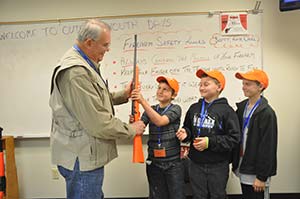Are we teaching kids to use dangerous weapons that create a more violent world, or how not to do so? Apparently, that depends on whether you ask the U.S. Department of Education (DoEd), or the governments of all 50 states.
In the 2022 “Safer Communities Act,” Congress included a provision eliminating funding for school programs that provide “dangerous weapon training.” DoEd now says that includes hunter safety training, the elimination of which “would help create a safer and more positive environment in schools.”
Just as President Biden signed that prohibition into law, Colorado Governor Jared Polis signed an opposite new law – specifically authorizing public schools to offer hunter safety classes to all 7th graders. Illinois, Michigan, and Missouri recently passed similar laws. All 50 states require hunter safety classes and certification as a precondition for licensing new hunters. The universal view is that people should not be given hunting licenses who have no safety training. All states provide such training, either directly through their fish and game agencies, or by certified contractors. Many states also provide the training through public schools, usually as an elective and generally requiring parental consent. That is because, of course, hunting involves the use of dangerous weapons.
So, what is the purpose of hunter education for kids? Is it, as the federal government seems to think, teaching them to use weapons dangerously, or teaching them not to do so?
It comes as no surprise that the federal department is run by people with little experience in hunting. The percentage of Americans who hunt (roughly five percent) is far less than it once was, and it’s a safe bet that the number is even smaller among federal employees in Washington, D.C. But even if they themselves are not hunters, have they really forgotten the value of hunting?

It is not just economic, though that impact is enormous. According to the Sportsmen’s Alliance, Hunting and sport shooting contribute $150 billion to the economy annually, support 970,000 jobs, and generate $45 billion in wages. Yet the role hunters play in wildlife management may be even more important. A recent Durango Herald headline told the story: “Why hunting groups are leading the charge on wildlife conservation in Southwest Colorado: Hunters are fundraising, sharing knowledge, and doing restoration projects to protect wildlands.” That’s nothing new.
From the first European colonists in America to the end of the 19th Century, there were almost no rules. John Jacob Astor became the world’s richest man while attempting to trap every beaver in North America (and almost succeeding). Settlers that Daniel Boone led through the Cumberland Gap eliminated nearly all the deer, elk, and buffalo from the Midwest within about 30 years. U.S. government-financed hunters slaughtered all but 541 of the 60 million American bison by the 1880s.
At the risk of educating DoEd bureaucrats, though, it wasn’t the government that saved the buffalo, or the white-tailed deer, or the wild turkey – it was hunters. No one has a stronger interest in ensuring sufficient wild game for the future than hunters. It was the Boone and Crocket Club, founded by hunters like Theodore Roosevelt and George Bird Grinnell, whose interest in saving the bison led to a ban on commercial hunting, now the law in every state. Hunters pushed for the Migratory Bird Treaty Act of 1918, the Conservation Stamp Act of 1934, the Wildlife Restoration Act of 1937, and especially the Pittman-Robertson Act, which dedicates funds from the sale of guns and ammunition to wildlife management. Today, 75 percent of federal and state wildlife agency budgets come from anglers and hunters.
So why this new federal attack on the future of hunting? If officials really worry that guns are dangerous, which is obvious enough, doesn’t it make more sense to teach gun safety than to ignore it? Hunter Education classes teach hunters to be safe, legal, and responsible. They cover wildlife management, wildlife identification, ethics, and regulations, in addition to safe handling of firearms.
Some programs are statewide, but most are implemented by local school boards. It is unclear why Colorado needed the new law, as it was among the first states to implement hunter education decades ago. When I was in 7th grade, that training was offered through District 51 schools, even required for boys. I have not spent the rest of my life hunting, but I certainly know guns are not toys, and how to handle them safely. That training doesn’t make guns more dangerous around me – it makes them safer.




Comments on this entry are closed.